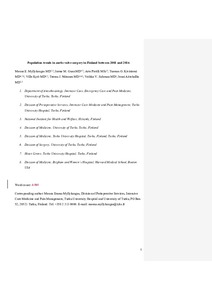Population trends in aortic valve surgery in Finland between 2001 and 2016
Monna E. Myllykangas; Jarmo M. Gunn; Tuomas O. Kiviniemi; Ville Kytö; Arto Pietilä; Teemu J. Niiranen; Veikko V. Salomaa; Jenni Aittokallio
Population trends in aortic valve surgery in Finland between 2001 and 2016
Monna E. Myllykangas
Jarmo M. Gunn
Tuomas O. Kiviniemi
Ville Kytö
Arto Pietilä
Teemu J. Niiranen
Veikko V. Salomaa
Jenni Aittokallio
TAYLOR & FRANCIS LTD
Julkaisun pysyvä osoite on:
https://urn.fi/URN:NBN:fi-fe2021042822845
https://urn.fi/URN:NBN:fi-fe2021042822845
Tiivistelmä
Objectives. To investigate nationwide changes in procedure rates, patient selection, and prognosis after all surgical aortic valve replacements.
Design. Patients undergoing primary surgical aortic valve replacement between 2001 and 2016 were identified from three nationwide registers with compulsory reporting to examine trends in aortic valve surgery over four four-year time periods.
Results. A total of 12,139 surgical aortic valve replacement procedures (mean age 61.9 +/- 11.8 years, 39.1% women) were performed. The total number of biological valves increased from 1001 (42.9%) to 2526 (75.5%) from 2001-2004 to 2013-2016 (p < .001). During the first and last time periods the comorbidity burden increased; share of patients with hypertension increased from 37.5% to 46.9% (p < .001), diabetes from 14% to 16.5% (p = .01) and previous stroke from 5.2% to 7.2% (p = .01). The proportion of women undergoing surgery decreased from 40% to 36.1% from 2001-2004 to 2013-2016, respectively (p = .01). Overall 28-day mortality was 3.5%. In patients with biologic valve the multivariable-adjusted risk of short-term mortality decreased steadily in every four-year period from 2001-2004 to 2005-2008 (HR, 0.66; 95% CI 0.47-9.92), 2009-2012 (HR, 0.54; 95% CI, 0.39-0.75) and 2013-2016 (HR, 0.41; 95% CI, 0.29-0.58), whereas short-term mortality remained similar in patients with mechanical valve. The risk of four-year postoperative mortality after all surgical aortic valve replacements stayed constant.
Conclusions. The use of biologic aortic valve prosthesis has increased from 2001 to 2016. The proportion of women has declined markedly. The short-term mortality has decreased and the long-term mortality has stayed constant despite increasing comorbidity burden.
Kokoelmat
- Rinnakkaistallenteet [19207]
